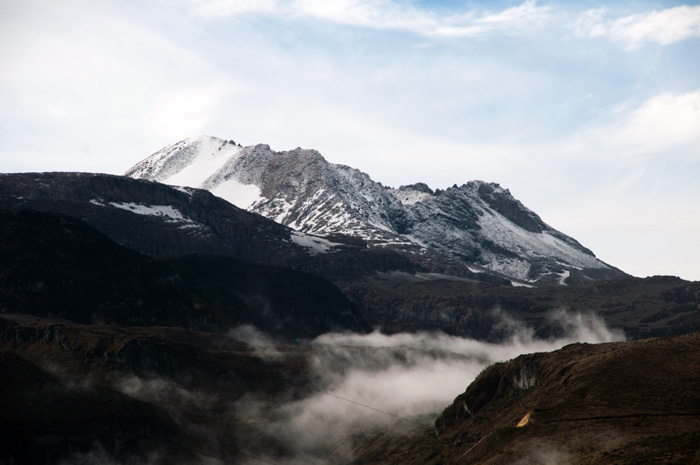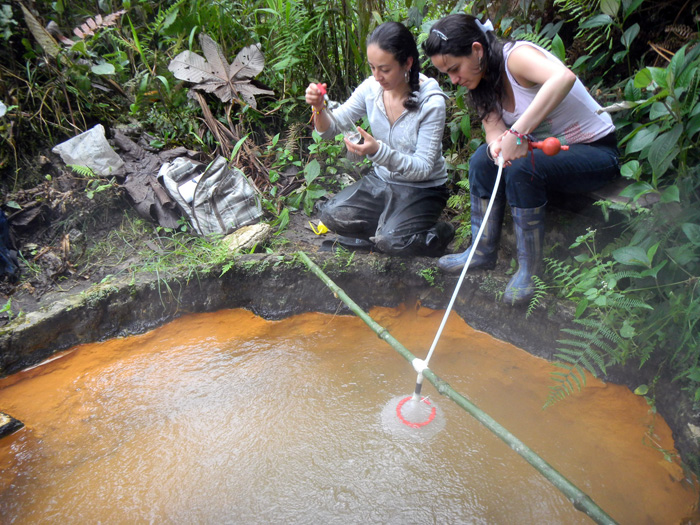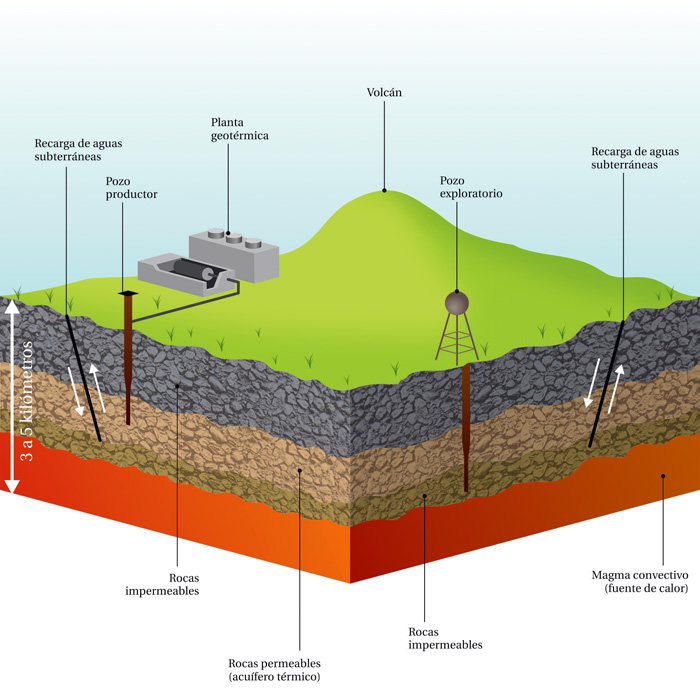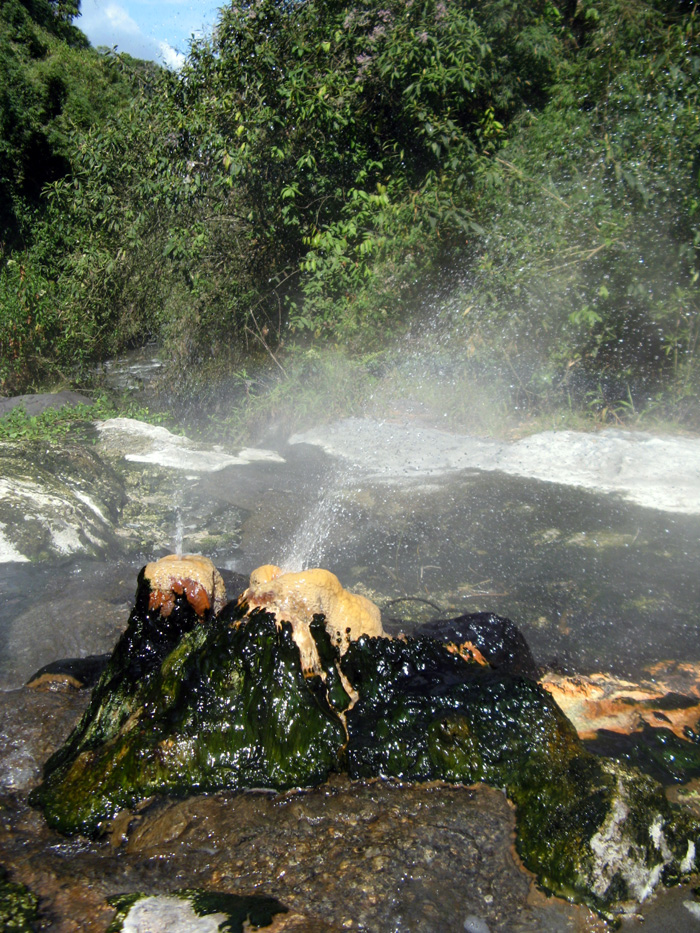This natural resource, with low environmental impact, is obtained from the internal heat of the soil. The first sources were already identified in Nevado del Ruiz Volcano.
Heat that exists in the nucleus of the Earth is transferred to the surface in a particular type of energy called geothermic, which is expressed in zones near volcanoes. There, incandescent rocks increase the temperature of rainwater and filter it into the subsoil, a situation tha generates the energy. This process, known as hydrothermal system, is also used for medicinal baths, tourism and agriculture.
For generating electricity, the temperatures of steam, hydrothermal water or rocks should be higher than 150°C. Heath extraction is made through the drilling of wells to reach the deepest rocks called reservoirs. Water and steam are extracted by using tubes that take them to a turbine that moves an electric generator. The excess of material is re-injected again into the reservoir in a cyclical and natural way. Then, the energy produced is sent to the national electricity network to fulfill the energetic demand.
Due to its geological characteristics and the presence of 13 active volcanoes, Colombia has a big potential to obtain geothermic energy. Sources of thermal water surrounding these areas are a testimony of this idea.
Nevado del Ruiz, "a sleeping lion"
In the middle of deep narrow valleys and high peaks, surrounded by unique species in the worlds such as the parrot of the peaks and the moorland hummingbird, Nevado del Ruiz, the biggest volcano in the Cordillera Central mountain ranges and one of the most active volcanoes in the planet, is located.
With its 5,321 meters high and a location that covers the departments of Caldas and Tolima, the volcano is characterized by its periodic explosive eruptions, and its multiple layers of hardened lava (pyroclastic material) and volcanic ashes. Within the volcano, there are three craters, and its top is covered by a volume of 1,200 and 1,500 million cubic meters of ice.
The important thermal sources and fumaroles of its surroundings represent the possibility of obtaining geothermic energy, somehting that Colombian and foreign scientists have been looking for since the 60s.
However, up to now, no project had been able to confirm the existence of a hydrothermal system, a necessary element to obtain this resource. For this reason, Universidad Nacional de Colombia, Ingeominas, Isagen, and Colciencias, have been exploring the volcano"s surroundings for 12 months, as part of the most ambitious project of geothermic energy developed in the country to use this natural resource.
"The information obtained in the technical and scientific studies allows considering the existence of two hydrothermal systems. The fist comes from a source of heat located under Nevado del Ruiz"s main crater, and the other located on the southwest," asserted Carlos Zuluaga, Professor of the Department of Geosciences at Universidad Nacional de Colombia.
Costs and risks
This is a long term, expensive and risky project. The development of the phases that will determine the possibility of generating energy will take five years.
The costs of the study up to the exploration phase could cost over 30 million dollars, without the certainty of the existence of this resource. However, the potential of this volcano is high, but it is just until the model is finished that it will be possible to know if the source to produce energy exists.
With this project, a model of the magmatic hydrothermal system will be created: "we will establish the current composition of the volcano, fluid distribution and components of the system (such as magma), presence of permeable rocks and seal layer," explained Professor Zuluaga, main researcher.
The exploration phase will start in 2012 by drilling five wells at depths of up to 2 to 3 km (each with an estimate cost of 5 million dollars). If the presence of this resource is proved, the well for production and reinjection of water will be drilled by the end of 2013. The next step will be the construction of a plant for the generation of eclectic energy, operated by Isagen.
Recourse with more than 100 years
The capacity of electricity generation in Colombia is close to 14,000 megawatts (MW) per year. Since the country counts on enough water resources, 70% of the energy is produced by hydroelectric sources; however, this does not guarantee the absence of restrictions in the service supply, a situation that occurred in the 90s, then the supply was restricted due to lack of water in the reservoirs. The rest comes from thermal energy produced by gas, coal and other fuels.
Due to this dependence, Isagen and other companies promote the development of non conventional sources of energy, such as the geothermal production, characterized for being one of the cleanest sources of energy, since it does not emit polluting gases to the air, or generate solid waste or liquids that are thrown into the water. This reduces the climate change effects and gas emissions.
"In 2005, close to 24 countries produced electric energy from geothermal sources, and 78 were generating it for indirect uses such as heating, refrigeration, health care centers, fish farming, and industry," asserted the Professor from Universidad Nacional de Colombia.
In Colombia, other potential zones for the production of geothermal energy have been identified, such as Azufral volcano in the country"s south; the northeast region of Boyaca (Paipa and surrounding areas), and Nevado de Santa Isabel volcano, also located in Cordillera Central mountain ranges.
However, due to the development of all phases and subsequent drillings, this project will confirm if Colombia will count on a different source of energy that not only benefits the environment, but also has the capacity of constantly produce clean and high quality energy without depending on climatic factors or fossil fuels. This resource will increase the electricity scope and supply at national level.
Please visit http://www.unperiodico.unal.edu.co/dper/article/sacaran-energia-de-suelos-volcanicos.html , if you want to read the complete article.
 Correo Electrónico
Correo Electrónico
 DNINFOA - SIA
DNINFOA - SIA
 Bibliotecas
Bibliotecas
 Convocatorias
Convocatorias
 Identidad UNAL
Identidad UNAL






